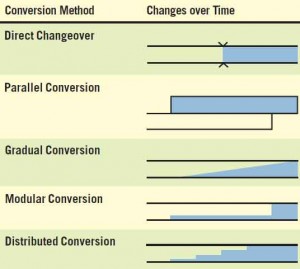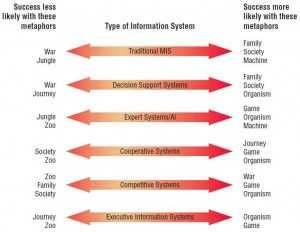A third approach to implementation is physically converting the old information system to the new or modified one. There are many conversion strategies available to analysts, and also a contingency approach that takes into account several user and organizational variables in deciding which conversion strategy to use. There is no single best way to proceed with conversion. The importance of adequate planning and scheduling of conversion with the strategic involvement of users (which often takes many weeks), file backup, and adequate security cannot be overemphasized.
Conversion Strategies
The five strategies for converting from the old system to the new are given in the figure illustrated below are as follows:
- Direct changeover.
- Parallel conversion.
- Gradual, or phased, conversion.
- Modular conversion.
- Distributed conversion.

Each of the five conversion approaches is described separately in the following subsections.
Conversion by direct changeover means that, on a specified date, users stop using the old system and the new system is put into use. Direct changeover can only be successful if extensive testing is done beforehand, and it works best when some delays in processing can be tolerated. Direct changeover is considered a risky approach to conversion. Disruption to the work environment may occur if users resent being forced into using an unfamiliar system without recourse. Finally, there is no adequate way to compare new results with old.
Parallel conversion refers to running the old system and the new system at the same time, in parallel. When the same results can be gained over time, the new system is put into use and the old one is stopped. One advantage of running both systems in parallel is the possibility of checking new data against old data to catch any errors in processing in the new system. The main disadvantages include the cost of running two systems at the same time and the burden on employees of virtually doubling their workload during conversion.
Gradual, or phased, conversion attempts to combine the best features of the two previously mentioned plans, without incurring all the risks. In this plan, the volume of transactions handled by the new system is gradually increased as the system is phased in. The advantages of this approach include allowing users to get used to the system gradually, the possibility of detecting and recovering from errors without a lot of down time, and the ability to add features one-by-one. Agile methodologies tend to use this conversion approach.
Modular conversion uses the building of self-contained, operational subsystems to change from old systems to new in a gradual manner. As each module is modified and accepted, it is put into use. One advantage is that each module is thoroughly tested before being used. Another advantage is that users are familiar with each module as it becomes operational. Their feedback has helped determine the final attributes of the system. Object-oriented methodologies often use this approach.
Distributed conversion refers to a situation in which many installations of the same system are contemplated, as is the case in banking or in franchises such as restaurants or clothing stores. One entire conversion is done (with any of the four approaches considered previously) at one site. When that conversion is successfully completed, other conversions are done for other sites. An advantage of distributed conversion is that problems can be detected and contained rather than inflicted simultaneously on all sites. A disadvantage is that even when one conversion is successful, each site will have its own people and culture, along with regional and local peculiarities to work through, and they must be handled accordingly.
Other Conversion Considerations
Conversion also entails other details for the analyst, which include the following:
- Ordering equipment (up to three months ahead of planned conversion).
- Ordering any necessary materials that are externally supplied to the information system, such as toner cartridges, paper, preprinted forms, and magnetic media.
- Appointing a manager to supervise, or personally supervising, the preparation of the installation site.
- Planning, scheduling, and supervising programmers and data entry personnel who must convert all relevant files and databases.
For many implementations, your chief role will be accurately estimating the time needed for each activity, appointing people to manage each subproject, and coordinating their work. For smaller projects, you will do much of the conversion work on your own. Many of the project management techniques discussed in Chapter “Project Management“, such as Gantt charts, PERT, function point analysis, and successfully communicating with team members, are useful for planning and controlling implementation.
Organizational Metaphors and Their Relationship to Successful Systems
Be aware of organizational metaphors when you attempt to implement a system you have just developed. Our research has suggested that the success or failure of a system may be related to the metaphors used by organizational members.
When people in the organization describe the company as a zoo, you can infer that the atmosphere is chaotic; if it is described as a machine, everything is working in an orderly fashion. When the predominant metaphor is war, journey, or jungle, the environment is chaotic, as with the zoo. The war and journey metaphors are oriented toward an organization goal, however, whereas the zoo and jungle metaphors are not.
In addition to the machine, metaphors such as society, family, and the game all signify order and rules. Although the machine and game metaphors are goal oriented, the society and zoo metaphors do not stress the company’s goal, but instead allow individuals in the corporation to set their own standards and rewards. Another metaphor, organism, appears balanced between order and chaos, corporate and individual goals.
Our research suggests that the success or failure of a system may have something to do with the predominant metaphor. Figure below shows that a traditional MIS will tend to succeed when the predominant metaphor is society, machine, or family, but it might not succeed if the metaphor is war or jungle (two chaotic metaphors). Notice, however, that competitive systems will most likely succeed if the metaphor is war.

Positive metaphors appear to be game, organism, and machine. Negative metaphors appear to be jungle and zoo. The others (journey, war, society, and family) show mixed success depending on the type of information system being developed. More research needs to be done in this area. In the meantime, the systems analyst should be aware that metaphors communicated in interviews could be meaningful and may even be a contributing factor toward the success of the information system implementation.
